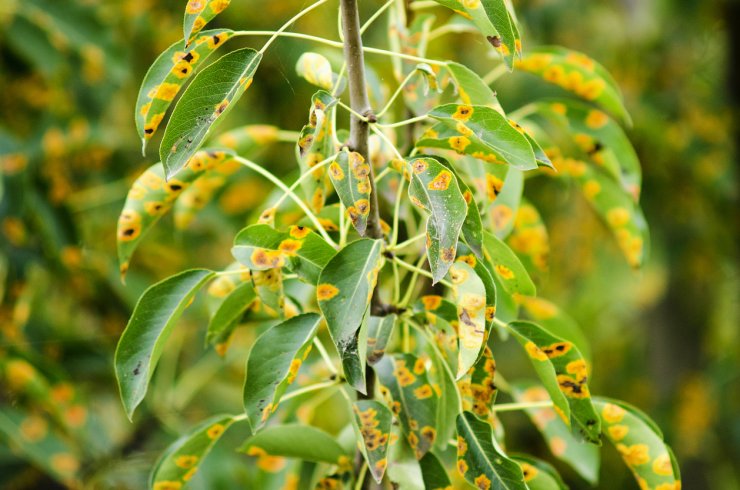
Pear leaves suffering from disease.
All pear trees are at some risk of pests and disease; location and weather will influence which pests and diseases are most likely to be a risk factor for your trees.
There are two key strategies for keeping your trees free of pests and disease: proper maintenance (watering, pruning, weeding, raking) and purchasing disease-resistant cultivars.
If you suspect that your tree is suffering from a disease or pest infestation, try to find a sample branch or fruit that is showing symptoms. First, take some clear, close-up pictures. Then cut the sample from the tree and seal it in a clear bag. Take it to your local nursery or extension center for detailed diagnosis.
Fire blight is far and away the worst disease that can strike a pear tree. There is no cure for this bacterial disease that causes the tree branches to blacken and die. Your best defense is to cut back infected branches to where you have green, healthy growth. Be sure to disinfect your pruning tools with bleach between pruning cuts (you do not want this infection to spread to other parts of the tree or to other trees). Do not compost infected wood. Throw it out.
There are many varieties of European pear tree that are resistant to fire blight. Asian pears tend to be more even more resistant to fire blight than their European counterparts.
Bitter rot occurs on apple and pear trees—but only on the fruit. This fungal disease is one of the few that can penetrate the skin of the developing fruit; it doesn’t need a preexisting wound on the fruit to take hold.
Rot spots appear on the sun-facing side of the fruit, and show up as tiny, light brown, circular spots. If the humidity is high, these spots turn dark brown fairly quickly. When the spots reach 1/8 to 1/4 inch in diameter, you’ll notice a distinct sunken, saucer shape. If the spots get to 1/2 inch in diameter, you’ll see small black dots in the spots; these are the fruiting bodies of the fungus. You may notice they’re formed in concentric rings.
Later, the spots begin to ooze spores in a pink, gelatinous mass—which can easily spread to other pears on your tree when it rains. Infected fruit decays even as it’s ripening, eventually shriveling into a mummy. If you find a lot of pears marked with bitter rot, follow the infection up the tree until you find the first instance. Then throw out all infected fruit.
Fungal spores like to hang out for the winter, snug in mummified pears or packed into cracks and crevices in the tree branches. If you have any broken limbs on your trees, cut off the jagged edges and throw that wood away. Do a thorough cleanup around your tree to get rid of any infected fruit. When the warm weather comes back, so does the bitter rot. It thrives in high heat and high humidity. Try to remove any potential sources; then keep a watchful eye on your trees as your next crop of pears develops.
Pear scab is relatively rare but destructive. This fungal infection can occur on leaves, shoots, and fruits. Watch out for dark, circular, velvety-looking spots—these are the spores settling in. The fruits are more susceptible when they’re young. Scab lesions on the leaves may appear anywhere between eight days and two months after infection. The fungus that causes pear scab will spend the winter in leaves on the ground and on infected twigs. Wind and rain can spread the infection in the spring.
You can treat fungal infections on your trees using fungicide. Check with your local nursery or extension center for advice on the best type for your trees. And when fall cleanup time comes around, pick up excess leaf litter; your trees will thank you.
Other pear tree diseases include pear rust, blossom wilt, pear leaf spot, leaf blight, and crown gall. When in doubt, take pictures and samples, and go for a consult.
Have your pear trees faced any diseases? How have you handled treating or preventing diseases on your pear trees? Please share your experiences with everyone in the comments below.


 Previous
Previous


Fire blight is our nemesis. It starts at the tip of the limb and moves toward the trunk of the tree. If you find it, cut at least 12 – 18 inches away from the infection to ensure you remove all damaged limb material. We even dip our loppers in a water/bleach solution for each cut, so we don’t spread the bacteria from one limb to the next. Be vigilant watching for a recurrence.